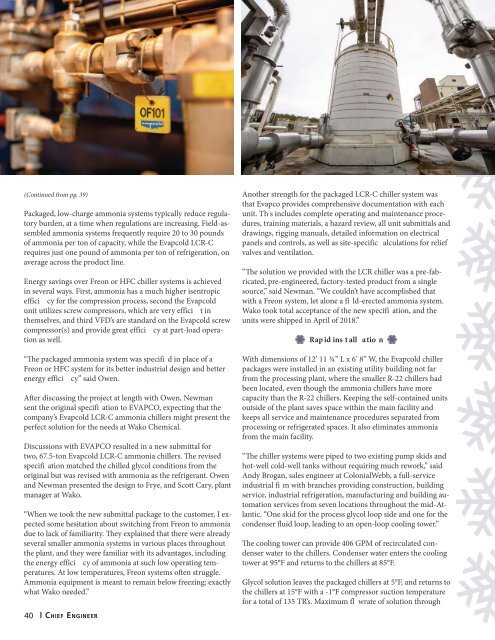CEAC-2022-09-September
You also want an ePaper? Increase the reach of your titles
YUMPU automatically turns print PDFs into web optimized ePapers that Google loves.
(Continued from pg. 39)<br />
Packaged, low-charge ammonia systems typically reduce regulatory<br />
burden, at a time when regulations are increasing. Field-assembled<br />
ammonia systems frequently require 20 to 30 pounds<br />
of ammonia per ton of capacity, while the Evapcold LCR-C<br />
requires just one pound of ammonia per ton of refrigeration, on<br />
average across the product line.<br />
Energy savings over Freon or HFC chiller systems is achieved<br />
in several ways. First, ammonia has a much higher isentropic<br />
effici cy for the compression process, second the Evapcold<br />
unit utilizes screw compressors, which are very effici t in<br />
themselves, and third VFD’s are standard on the Evapcold screw<br />
compressor(s) and provide great effici cy at part-load operation<br />
as well.<br />
“The packaged ammonia system was specifi d in place of a<br />
Freon or HFC system for its better industrial design and better<br />
energy effici cy” said Owen.<br />
After discussing the project at length with Owen, Newman<br />
sent the original specifi ation to EVAPCO, expecting that the<br />
company’s Evapcold LCR-C ammonia chillers might present the<br />
perfect solution for the needs at Wako Chemical.<br />
Discussions with EVAPCO resulted in a new submittal for<br />
two, 67.5-ton Evapcold LCR-C ammonia chillers. The revised<br />
specifi ation matched the chilled glycol conditions from the<br />
original but was revised with ammonia as the refrigerant. Owen<br />
and Newman presented the design to Frye, and Scott Cary, plant<br />
manager at Wako.<br />
“When we took the new submittal package to the customer, I expected<br />
some hesitation about switching from Freon to ammonia<br />
due to lack of familiarity. They explained that there were already<br />
several smaller ammonia systems in various places throughout<br />
the plant, and they were familiar with its advantages, including<br />
the energy effici cy of ammonia at such low operating temperatures.<br />
At low temperatures, Freon systems often struggle.<br />
Ammonia equipment is meant to remain below freezing; exactly<br />
what Wako needed.”<br />
40<br />
| Chief Engineer<br />
Another strength for the packaged LCR-C chiller system was<br />
that Evapco provides comprehensive documentation with each<br />
unit. Th s includes complete operating and maintenance procedures,<br />
training materials, a hazard review, all unit submittals and<br />
drawings, rigging manuals, detailed information on electrical<br />
panels and controls, as well as site-specific alculations for relief<br />
valves and ventilation.<br />
“The solution we provided with the LCR chiller was a pre-fabricated,<br />
pre-engineered, factory-tested product from a single<br />
source,” said Newman. “We couldn’t have accomplished that<br />
with a Freon system, let alone a fi ld-erected ammonia system.<br />
Wako took total acceptance of the new specifi ation, and the<br />
units were shipped in April of 2018.”<br />
Rap id ins t all atio n<br />
With dimensions of 12’ 11 ¾” L x 6’ 8” W, the Evapcold chiller<br />
packages were installed in an existing utility building not far<br />
from the processing plant, where the smaller R-22 chillers had<br />
been located, even though the ammonia chillers have more<br />
capacity than the R-22 chillers. Keeping the self-contained units<br />
outside of the plant saves space within the main facility and<br />
keeps all service and maintenance procedures separated from<br />
processing or refrigerated spaces. It also eliminates ammonia<br />
from the main facility.<br />
“The chiller systems were piped to two existing pump skids and<br />
hot-well cold-well tanks without requiring much rework,” said<br />
Andy Brogan, sales engineer at ColonialWebb, a full-service<br />
industrial fi m with branches providing construction, building<br />
service, industrial refrigeration, manufacturing and building automation<br />
services from seven locations throughout the mid-Atlantic.<br />
“One skid for the process glycol loop side and one for the<br />
condenser fluid loop, leading to an open-loop cooling tower.”<br />
The cooling tower can provide 406 GPM of recirculated condenser<br />
water to the chillers. Condenser water enters the cooling<br />
tower at 95°F and returns to the chillers at 85°F.<br />
Glycol solution leaves the packaged chillers at 5°F, and returns to<br />
the chillers at 15°F with a -1°F compressor suction temperature<br />
for a total of 135 TR’s. Maximum fl wrate of solution through<br />
<strong>09</strong>22 issue.indd 40 8/22/22 3:27 PM
















